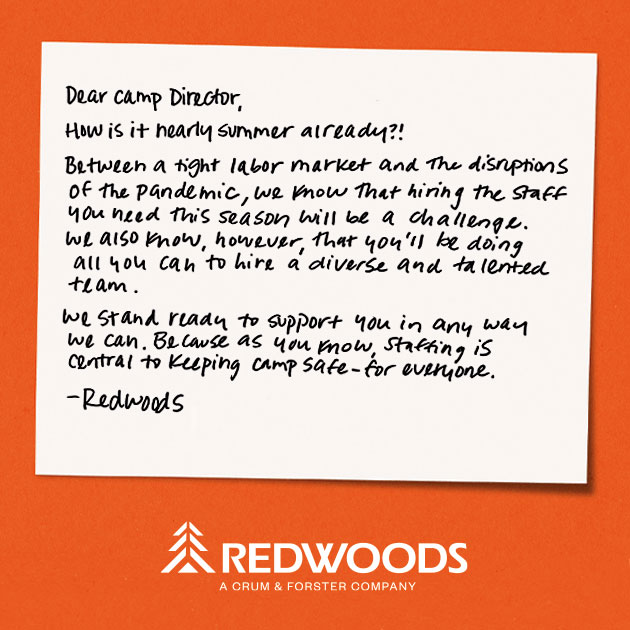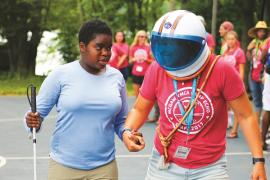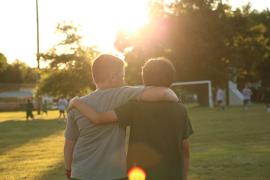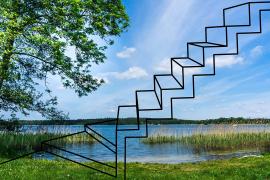In her 20s, Jennifer Brown moved to New York City to pursue a career as an opera singer, but recurring problems with her vocal cords that would require several surgeries put her on a path to a new career, one that made her voice an instrument of change as a globally recognized thought leader in diversity, equity, and inclusion (DEI). As a white, cisgender member of the LGBTQ+ community, Brown recognizes both the privileges that help some of us thrive, and the challenges that can get in the way of doing our best work. “But there is nothing wasted in our lives,” she says. “Our experiences are fodder for how we show up and how we can build bridges to each other.”
With the release of the second edition of Brown’s 2019 book How to Be an Inclusive Leader: Your Role in Creating Cultures of Belonging Where Everyone Can Thrive (available October 4 wherever books are sold), the founder of Jennifer Brown Consulting sat down with Camping Magazine to talk about inclusive leadership competencies and some of their implications for camps.
You said, “The same qualities that were once seen as signs of ‘weakness’ have now emerged as the key attributes of effective leadership." What are those attributes? And what’s your working definition of an inclusive leader?
To back up to go forward, what were the hallmarks of great leaders? They were attributes like having all the answers, giving strong direction, leading through command and control — all very hierarchical.
Yesterday’s strong leaders took the stance that what you do on your personal time and who you are really is irrelevant. They treated their people as just a piece of a process or a system.
But that was already coming apart before the pandemic, being challenged by younger generations coming into the workforce who had grown up in a very different world where they were more validated for who they are than my generation was. They came into their professional lives feeling more empowered, in touch with, and more comfortable talking about their identities. It’s caused a lot of consternation and discomfort generationally, because it’s not the way we [older generations] were taught what was right. We might even disagree that it’s appropriate. But certainly we’re uncomfortable because we’ve never done it, and we’re not sure what the purpose is.
So, in many ways, inclusive leadership is the opposite of the things I just named. It’s being vulnerable and real. It’s not having all the answers because we are leading in an ambiguous time, but asking the right questions and inviting input. It is having curiosity. It is being deeply empathetic — and empathetic for experiences that you don’t hold yourself, which is an important distinction, because organizational leaders and the top couple levels of most companies are largely white, male, and straight. It’s really understanding that navigating the various reactions to our identity because of hidden or overt bias in others can be exhausting when you’re on the receiving end, and bad for our emotional and physical health. Room has to be given for that, rather than having things be swept under the rug, which is what the historical practice was. In addition, inclusive leaders must be willing to be vulnerable, transparent, and authentic. They must be emotionally intelligent advocates, being very proactive around equity in their organizations and conscious of where there are inequities. It is incumbent on good leaders to point things out, to make noise, to say, “Hey, that’s not an equitable practice. We need to do better.”
It’s a changing of the guard then?
That’s a tension that’s going on in most systems. And then add the pandemic, the Black Lives Matter movement, which was further galvanized by George Floyd’s murder, the truth-telling conversations that happened among so many people and within so many workplaces, and about work in general. People had been already saying, “I don’t feel engaged.” “I don’t feel psychologically safe in my workplace.” What does identity have to do with that? I think so many of us got schooled within the last few years — especially those of us who feel relatively comfortable in systems that were built by and for people who identify as we do.
Some of us woke up to the fact that this same system could feel radically different for others. I like to say we’re in the same storm, but we’re in different boats. We may have the same circumstances at work but a very different experience.
More people began to realize the impact of microaggressions, what they are even, and how they leave people feeling diminished. We began asking, “How do our biases show up? Who do we protect, who do we promote, and whom do we see as leaders? How do we view potential — and how do our biases hold us back from really seeing true potential?”
You created an Inclusive Leader Continuum with four stages. Why, what are the stages, and how does one use this continuum to inform their journey toward becoming an inclusive leader?
I created the four-phased model because it felt like people were swimming in confusion and not sure what the right next steps were. I think it’s so important for us to feel like there’s some kind of plan, an anchor for us in terms of where we are in our evolution as leaders.
The four phases speak to the stages in our evolution, but they aren’t linear. We don’t achieve one and put it behind us. We’re constantly moving forward in our knowledge and our confidence, and then sometimes we need to go back or have an aha moment where we realize that we’re really in the early stages. And that’s totally OK, and why I built it in a circular shape and not linear. Because it’s not about reaching the destination. That’s impossible. It’s all about the journey.
The four phases are Unaware, Aware, Active, and Advocate.
Unaware, the first phase, is I’m asleep. I don’t know there’s a problem. Maybe I presume that the playing field is and always has been fairly level and fair to everyone. Or I think I’m a good person and I do enough. A lot of us have rested on our interpretation of what doing enough looks like — but intending something is very different than having the impact that we want and that is needed.
The goal is to lift out of unawareness, to awaken, to begin to notice things in ourselves and in the environment that are not inclusive, that are problematic, that are biases — and we all have them — and while we can’t eradicate them, there are ways to begin to see and address them by making different choices.
So the second phase, Aware, is about noticing the bubbles we live in and their limitations. Now we know there are so many different boats in that storm that we know nothing about, and we lean into that. We gain exposure and make goals for ourselves to diversify our friend network, get to know people who we wouldn’t normally approach, or put ourselves in environments where we’re not among people who identify as we do. It’s deepening the knowledge that we need for the journey. It’s an investment in ourselves, in our own language and terminology and self-knowledge. But we can’t stay in this phase because it lacks the action needed to shift systems.
So Active is the third phase: Here we have new conversations. We open doors. We begin to challenge ourselves and others perhaps more publicly. We share our stories or talk about our biases openly for the first time. We openly acknowledge differences and don’t pretend that they don’t have so much to do with people’s happiness and ability to thrive. We begin to lead. But this is still very much a practice stage. We’re still getting our feet under us; we’re still figuring out our language. We may get some negative feedback where we’re missing the mark. The important thing is to try and to believe that we can actually grow and evolve toward inclusive leadership at any age. This is never a door that’s closed to us — but it takes persistence and getting comfortable being uncomfortable.
Then the final phase is Advocate, where we’ve developed the skills, the competency, and also the confidence on our journey so far, and we’re ready to use them. We’re ready to hold ourselves and others accountable. We’re ready to make some noise and be insistent, persistent, and consistent in advocating for marginalized identities. This is a hard thing to live in all the time. Some of us will dip in and out depending on how deeply involved we are with a certain identity, whether it’s ours, somebody we love, or someone who we work with. We can be that advocate voice that knows what to say, when to say it, when to push, and where change is needed.
But we can’t be advocate level for all things. That’s one of the most important messages of the continuum. We’re still learning and at different phases with different identities — whether that’s people with disabilities, those of a different ethnicity, or our nonbinary friends, colleagues, and loved ones. I want us to be able to prioritize and take the right next step, which is going to look different for each one of us. We must think about where we sit in the system and what’s within our reach to create change. If we can just take that one step at a time, it’s good. And I’ll say one more thing: we should all along be activating from the privileged identities that we have, meaning we can make changes where someone else may not be able to. We may have the inside track. We may have the credibility that comes from academic credentials or the professional or social capital to know that when we speak, people listen. Those are privileges — and any kind of privilege comes with an opportunity to really address equitable change.
I think some people have a desire to be more inclusive, but they fear judgment or making a misstep, and they become paralyzed. But you said, “There isn’t a wrong starting point if your intent is to grow.” Can you elaborate on that?
Showing up imperfectly is one of those inclusive leader competencies. I like to say, “Let’s not make perfect the enemy of the good.”
When we speak openly and honestly about what we know, what we don’t know, and what we’re learning and feeling, it creates trust with others — because we’re not trying to be somebody we’re not.
We’re not pretending to have ability and competency that we don’t. And we role model vulnerability when we say, “I don’t know the answer to that,” or “I’m not certain how to approach this.” That to me is a huge first step in inclusive leadership. Many of us are in unfamiliar terrain and want so much to enable others in a landscape we don’t understand. It’s OK to say, “Here’s where I’m at, and here’s how you can help me. Here’s how I will help you. Here’s my commitment.” It’s OK to show up imperfectly and to talk about it, learn together, and give each other feedback. Our job is to continue to bounce back, to be resilient. Because we have to expect that this is going to be very experimental, and as uncomfortable as it can be, it’s how we grow – by extending ourselves.
Quoting you, “When it comes to disrupting the status quo and creating equity in the workplace, much power lies with leaders who set the standards and tone for everything from who gets hired and who advances to what the workplace culture looks like. We understand that without their buy-in and personal involvement, our efforts will have more limited impact and will be more difficult to sustain.” Does that mean that growing diversity, equity, and inclusion is a top-down strategy?
DEI has been championed within many organizations from a bottom-up perspective. We often think about affinity groups, employees taking matters into their own hands, if you will, and beginning to support each other, give feedback, and gather to identify opportunities for the organization. Sometimes the top has lagged behind that organic activity. And some companies have aligned DEI efforts to different underrepresented identities. So our organizational strategies typically focus in on each of these silos. While such a laser focus on how identity is represented in our workplace has been very important, it’s left some folks not knowing how to contribute, because they don’t share a lot of (or any of) those identities on a personal level. For their part, leaders have not stepped into the opportunity and made it their own. I don’t think that we can really achieve change unless it is driven from the top, the bottom, and the middle. However, missing the top-down piece does make everything harder, because folks at the top have the ability to make changes happen quickly and efficiently, and also to hold people accountable to make them real.
I really love the idea of reverse mentoring. I’m a big fan of flipping the script and thinking about how we can flatten the organizational hierarchy and make sure that the top is listening to the bottom is listening to the top. And the middle is involved as well, which is one of those really difficult things to do. Leadership teams talk about this stuff a lot, but I think it gets lost in the middle. Then you have the upswelling of the voice of Gen Z and younger millennial talent, but the middle is always a struggle to reach. It can be really disastrous when we don’t do a good job there — because those folks have everything to do with whether that younger generation talent stays or goes. Research shows that people leave roles mostly because of their direct boss or supervisor, not necessarily because of the job itself or the company. So DEI efforts really must come from and involve all levels.
Camp hasn’t historically been an extremely popular place for Black, Brown, or transgender campers. What advice do you have for camp leaders who have a desire to make their camps more equitable and diverse environments of belonging?
I look back at my camp experience through the lens that I have now, and these are hard questions. So many camps were founded long ago in a very different time, and they are so much about maintaining tradition. We get attached to our rituals at camp. We have our songbooks. We have our special days that we celebrate and dressing up for those. We look forward to those traditions, and we protect them. So this is hard work, because some of those activities are problematic, and examining them requires people to let go.
To really commit to inclusion means things that might feel sacred may need to change.
For example, the financial resources that people don’t have should be made available. And it’s not just tuition. It’s the travel budget to get there, the transportation, the resources that kids may or may not have to pack in their suitcases. If a camper is at camp for weeks and weeks and has Black hair, what is the plan to enable them to take care of that?
There’s a concept among the community with disabilities called “universal design.” The thinking is if something is designed to solve for a disability, then actually the design benefits all of us. As we think about camp restrooms and things like that, universal design allows for privacy if a camper needs that. That’s actually appealing to a broader cross-section of campers. It’s a huge opportunity to update our infrastructure. And maybe the impetus is to welcome campers of all different identities, including gender nonbinary. But good design is good design and enables a new level of comfort and psychological safety for many of us down the line.
And there just needs to be an acknowledgement that the relationship with the outdoors in general and with being in nature is more comfortable for white culture than for other cultures. Take something as common as a bonfire, for instance. I was talking to a friend who said some of her campers of color showed up to a big bonfire with others jumping around the fire in the middle of the woods where it was pitch black, with costumes and masks on, and she thought, What in the world? How can we expect this to be a comfortable place for people of certain histories, people who have been done violence in our country in those exact same places? We have to figure out how we can extend the beauty and the healing power of the outdoors to all and acknowledge the baggage that it comes with for some folks.
This examination and change is definitely an uphill battle, but if camps can’t do it, nobody can. Camps are such lovely places. They’re typically helmed by such loving humans. We can and must ensure they achieve their potential to be life-changing for all of our youth — just as camp was for me.
Photo courtesy of Camp Brave Trails, Los Angeles, CA.
Interview conducted by Marcia Ellett, Camping Magazine’s editor in chief.




